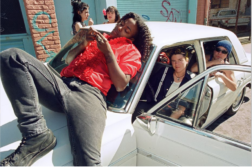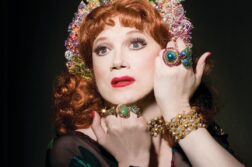The male nude has been an iconic subject for artists since Classical times, and it remains so today. Few people understand the power and beauty of the male figure better than Douglas Simonson, who has made male nudes the pillar of a successful, three-decades-long painting career. Often Simonson gives this subject a classic treatment in draftsmanlike drawings with a disciplined realism. But just as often, he shifts colors and warps shapes in startling flights of fancy. His new book, Brush and Camera, shows his paintings and drawings alongside the photographs he shot and worked from, affording stereoscopic glimpses into his creative process.
In addition to subject matter, many of his works share a strong sense of place—Hawaii, to be exact, where has lived since he was twenty. I reached him there by phone from Tokyo on June 30 my time, June 29 his time, 2007.
Tom Baker: Could you tell me about some of your major artistic influences?
Douglas Simonson: Picasso’s probably number one. Some things I admire about him are how much art he produced and how he stayed so vital and interested and interesting his whole life. You know, I’ve always kind of modeled myself, my artist’s life, after Picasso. Maybe a little more emotionally secure, I hope. Andrew Wyeth I’ve always liked. There’s an artist, a contemporary of mine, named Cornelius McCarthy, in England, whom I admire greatly. I’ve really looked at his work a lot over the last few years and learned a lot from it. And then there’s a cartoonist named Mike Mignola, who does the “Hellboy” cartoons, and he’s also a great inspiration for me.
TB: Your first book was Pidgin to Da Max (1983), which you illustrated in a cartoon-like style. Could you tell me a bit about how cartooning changed the way you deal with anatomy?
DS: It made a huge difference. Anybody who’s never tried to draw cartoons or been an artist probably doesn’t know this, but cartoons are harder to draw than realistic work. You really have to understand what you’re drawing in order to reduce it to a few lines and make it look like what it’s supposed to look like. I had to teach myself cartooning to do Pidgin to Da Max, and I had to become a lot more knowledgeable about anatomy specifically to be able to do that successfully. The amount of drawing and learning and refining that I did in order to be a decent enough cartoonist to do that book made me a much better artist on a lot of levels.
TB: In a piece called “Nohea in the Jungle” in Brush and Camera, I can definitely see Picasso, with the figure broken up into specific shapes. In looking at a particular image, how do you decide how you’re going to change it, or not?
DS: Quite often when I have a new model, I’ll start out doing pretty literal stuff, pencil drawings that are almost photographic in their realism. That’s the first step because I’m still kind of enchanted by the beauty of that model. Then, as I get used to it, and get that out  of my system, I start to see other things. Quite often there will be just a certain part of the photographic image. Maybe I’ll see a line or a color, some specific thing will trigger an image in my mind. Sometimes it’ll be fairly realistic and sometimes very distorted. It’s not something I have much control over. It appears. My job is just to be technically proficient enough to take advantage of those images when they come.
of my system, I start to see other things. Quite often there will be just a certain part of the photographic image. Maybe I’ll see a line or a color, some specific thing will trigger an image in my mind. Sometimes it’ll be fairly realistic and sometimes very distorted. It’s not something I have much control over. It appears. My job is just to be technically proficient enough to take advantage of those images when they come.
TB: In a few cases it seems you’ve almost put a new head on the model. For example, there’s a lot here of a model named Torano. In many cases, it’s definitely him. But in a few, like “Summer Swell,” you give him a completely different hairstyle, a much stronger jaw, craggier features—
DS: And the body is quite different too. I’ve turned him into this sort of iconic Hawaiian god. Let me explain that. There are certain models, and Torano is one them, that for me work as a kind of archetype. Torano, for a lot of reasons—his face and body and manner and the way he moves, the way he looks overall—just lend themselves to utilizing him as an archetype. I can twist him and elongate him and distort him and do all kinds of things with him. He just lends himself to that. It’s great to have a model like that. That’s one of the reasons you see so much of him in that book.
There are times when I have an idea and I need a model to express that idea. It’s not about that model. I’m using that model as a taking-off point to say what I want to say, and it has nothing to do with him. There are other times when it’s a lot about the model and I’m expressing my reaction to him while saying something about his personality.
TB: Could you tell me about working with a live model versus working from photos?
DS: I’m just a very practical kind of person. If I have a model sitting in front of me, they move, the light changes, I have to work when they’re there. Arranging all that and making it work is just a huge pain. To take a photograph solves all those problems. I can take a lot of photographs and then I have this whole bank of image material to work from whenever I feel like. There are artists and art educators who say you must draw from the live model. And I’m sure they have their point, but to me it’s just more trouble than it’s worth. And I like taking photographs, too. I’m also a photographer.
TB: When you were first starting out, the male nude was a subject you shied away from. Could you tell me a bit about that, and how you got over it?
DS: I grew up in Nebraska, in a cowboy town, and being gay was just anathema. It was the worst possible fate. Finally, I pretty much accepted that I was gay and it was okay, around the time I was twenty, but I still was embarrassed about showing people my drawings of male nudes. I finally got over that in my late twenties. I took this seminar called “The Advocate Experience.” It was a bit like est, but it was for gay people. It was really a watershed for me, and I got over a lot of my stuff. It was not long after that that I decided, “This is silly. I really love doing this, so I’m going to try it. I’m going to show people my work.” So I started doing that, and then of course the next surprise was that people wanted to buy them. About that time, I had quit my job and decided to become a painter. And it wasn’t working out at all, because I wasn’t doing male nudes. Then I started thinking, “Maybe I can make a business out of selling these male nudes until I decide what I really want to do.” And now, thirty years later, I’m still doing it.
TB: You market your work through your website (www.douglassimonson.com) rather than shows in galleries. Why is that?
DS: When I first started out in the late 70’s and early 80’s, I toyed with the idea of getting my work into galleries. Back in those days, and to some extent now, galleries were afraid to show male nudes. It was just too scary for them. In the 80’s and into the 90’s, I did go on tour. I’d take myself and an assistant and we would go to cities all over the U.S. and do shows. I would do a lecture and rent a hotel suite or a conference room. We’d take the art with us, we’d set it up on easels, and we’d just make a gallery for one night. I had to create my own marketing and distribution setup, and I did it by mail order, from around 1980 till about the mid 90’s. I did it all by mail, sending people slides. It was hugely tedious and time-consuming. But when the Internet became a reality, all of a sudden I was already set up ideally to take advantage of that, and it has made everything so much easier.
TB: Looking at your work, it appears Hawaii is a great place to find models. Why is that?
DS: There are a lot of places in the world that are great places to find models. But one of the nice things about this place is the racial diversity. The mixes are so amazing. You don’t really get the types of mixes we get here, in other parts of the world. Plus the climate is so good for people. Everybody looks great, they get tanned, everybody’s outside a lot. Our bodies are uncovered a lot of the time, so we’re more body-conscious. We just end up getting more exercise and being healthier, so that makes for more beautiful people generally.
Tom Baker is a co-author of Tokyo Chic.




